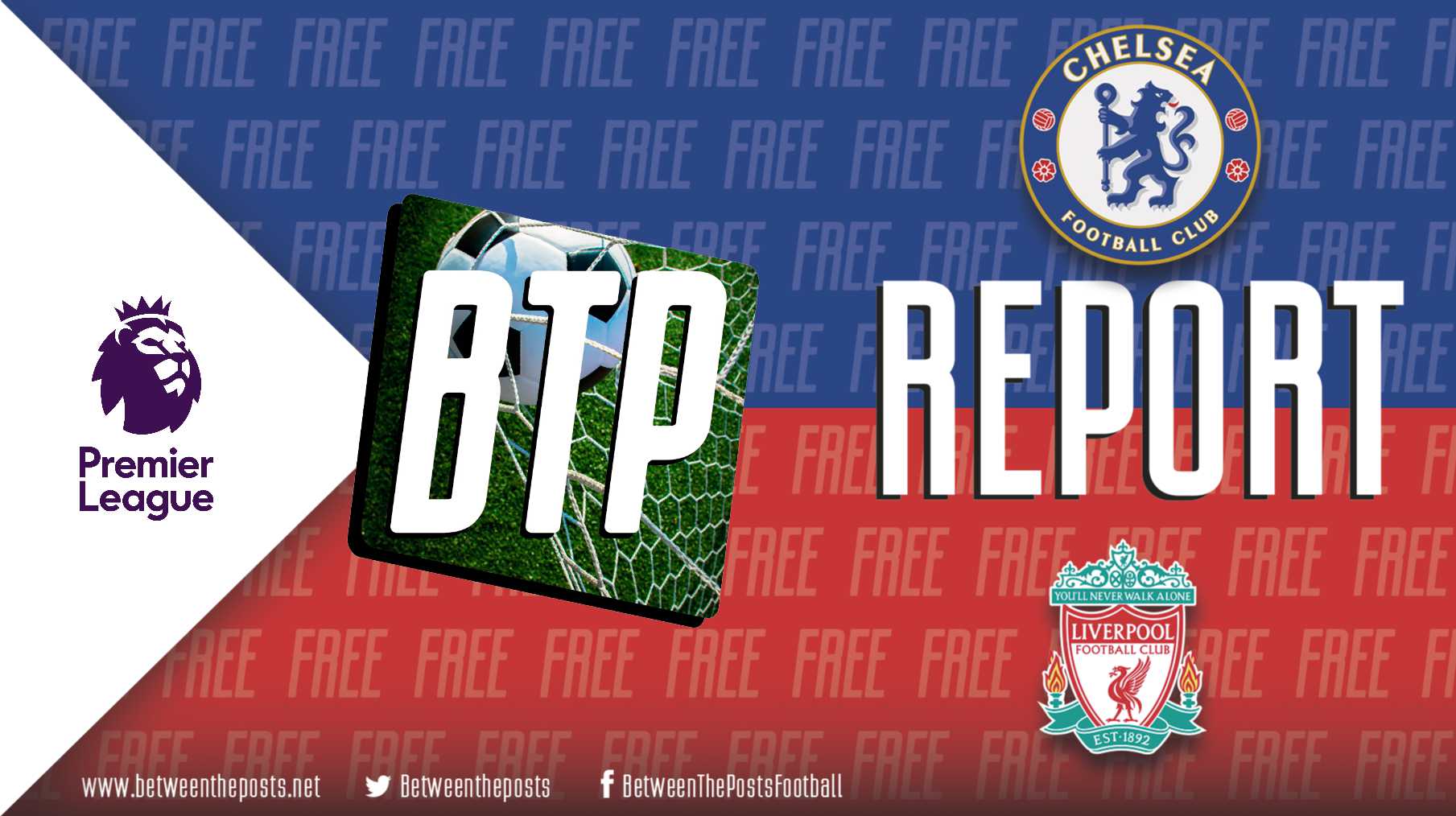Chelsea were strong in the organized phases of this match. Their man-oriented defending stifled Liverpool’s buildup, and their left-sided attacking strategy exploited gaps in Liverpool’s pressing. However, Liverpool retain a transitional threat and forced their way back into the game in the second half, only to be beaten in the last minute by an Estêvão winner.
Tactical analysis and match report by Josh Manley.
We decided to make this article free to read. If you want to support our work, consider taking a subscription.
After a winning start to the season, Liverpool’s fortunes had taken a turn in the week leading up to this match, as last weekend’s defeat at Crystal Palace was followed by a loss away at Galatasaray in midweek.
Chelsea meanwhile managed to secure victory in Europe this week when they hosted former boss José Mourinho’s Benfica side. In the league however, they had won just two of their first six games, with red cards in their last two matches against Manchester United and Brighton proving costly.
Enzo Maresca’s side lined up in a 4-3-3 shape here, with a back four of Reece James, Josh Acheampong, Benoît Badiashile, and Marc Cucurella. Moisés Caicedo was at the base of midfield with Malo Gusto and Enzo Fernández ahead of him, while Pedro Neto and Alejandro Garnacho played either side of João Pedro up front.
Liverpool meanwhile started with a 4-2-3-1 shape. Conor Bradley, Ibrahima Konaté, Virgil van Dijk, and Milos Kerkez made up the back four, with Ryan Gravenberch and Alexis Mac Allister in the double-pivot. Dominik Szoboszlai was chosen over Florian Wirtz as the number ten in support of Mohamed Salah, Cody Gakpo, and Alexander Isak in the frontline.
Chelsea’s man-marking
Maresca went with a man-oriented defensive scheme against Liverpool’s possession phases, and his team executed it relatively well in the first half. Chelsea played with good intensity against the ball, and Arne Slot’s side looked relatively listless in organized possession.
Chelsea’s midfield three had a relatively clear match-up against Liverpool’s midfield three in terms of marking assignments, with Caicedo, Gusto, and Fernández not having to stray far from their initial positions to make initial contact with Szoboszlai, Mac Allister, and Gravenberch respectively.
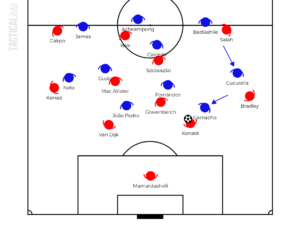
Chelsea in higher pressing.
Fernández did have a bit more running to do than the others, as Gravenberch sometimes dropped between the Liverpool center-backs, meaning Fernández would temporarily jump forward alongside João Pedro, who generally focused his pressing on Van Dijk.
Neto would track Kerkez’s forward runs on the left, whether they be inverting or overlapping. On the left, things were a bit different for Garnacho. His responsibility was to jump forward and press Konaté diagonally from his left-wing position when the Frenchman was on the ball, trying to force Liverpool back to the left side.
Garnacho generally executed this with good intensity. In higher pressing phases in Liverpool’s half, Garnacho’s pressing onto Konaté would be paired with Cucurella pushing forward onto Bradley, and Badiashile sliding across to pick up Salah on the right of Liverpool’s attack.
Despite their struggles in organized possession phases, Liverpool still had a couple of decent chances going forward as they still looked dangerous in transition moments, as they so often do. The home side did not help themselves in this respect, with some slightly sloppy play at times in the middle of the pitch affording Liverpool the chance to have fast-breaks against the Chelsea backline.
Chelsea attack down the left
In their own possession phases, Chelsea seemed to have quite a concrete idea of how to exploit Liverpool’s pressing system. For some time now, Liverpool’s game plan against the ball has allowed Salah to stay higher up and expend less energy in the defensive phase, in order to leave him fresh and well-positioned for counter-attacks in the right channel. They have reaped the rewards of this idea in recent years, but this game showed that there are also drawbacks.
Cucurella was able to find himself in plenty of space on the left side in this game by drifting into the space behind Salah. Chelsea could then look for him with third-man combinations to bypass Salah, or with direct passes when appropriate.
Gravenberch was often occupied by Fernández dropping in to assist Caicedo in the buildup around the number six area for Chelsea, while Bradley was pinned by Garnacho, and was actually bypassed on the couple of occasions where he tried to jump up onto Cucurella.
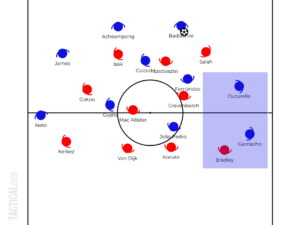
The left side was spacious for Chelsea due to Liverpool’s pressing scheme.
In general, it was far too easy for Chelsea to create two-versus-one situations against Bradley on that side, and Garnacho’s enthusiastic running with and without the ball stretched the Liverpool right back to his limit.
Although the left-sided attack was the main feature for Chelsea, their first goal also saw them exploit Liverpool in the center. Szoboszlai would sometimes try to join Isak in the first line of pressing against Chelsea’s center-backs, and on this occasion, they were bypassed. This left a three-versus-two in midfield with Caicedo as the spare man for Chelsea. They found him with a third-man combination that put him in oceans of space on the edge of Liverpool’s box, which he took advantage of with a rocket into the top corner.
When Chelsea had the ball higher up the pitch, they were generally in something of a 2-3-4-1 shape, with James inverting in the right halfspace and Gusto ahead of him making forward runs in support of João Pedro. Meanwhile Cucurella and Fernández occupied the higher and lower left halfspace positions flexibly, while Cucurella also made overlaps for Garnacho.
In general, Liverpool’s defensive phases were a bit unstable, with Chelsea always having an easy way to outplay their pressing down Salah’s side. Despite getting around Liverpool’s midfield on a fairly regular basis, Chelsea were not able to create that many clear shots at goal as the final third play lacked a bit of cutting edge.
Open second half
Slot made a change at half-time, removing Bradley who was walking a disciplinary tightrope on a yellow card in addition to his existing tactical difficulties against Chelsea’s left-sided attack. With Liverpool behind, Slot needed to be aggressive, so he moved Szoboszlai back to right back, and brought Wirtz into the number ten role.
Liverpool pressed more intensely from the start of the second half, including Salah who was a bit more urgent in his pressing movements towards Chelsea’s left-sided center-back. Wirtz marked Caicedo more tightly instead of trying to push up to the frontline as Szoboszlai had.
More changes came for both sides barely ten minutes later, as Slot added Andrew Robertson and Curtis Jones into the mix. Robertson was a straight swap for Kerkez, while Jones’ introduction in place of Konaté meant Gravenberch moved to center-back.
Maresca was forced into a reshuffle of his own when Badiashile went down injured. He brought on Roméo Lavia who played in central midfield, with James moving to center-back and Gusto to right back.
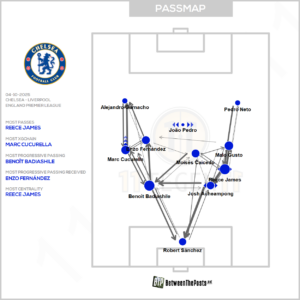
Chelsea had a decent left-side supply line through Badiashile, Cucurella, and Fernández, spearheaded by Garnacho.
The second half was quite an open affair overall. There were plenty of transitions for both sides and the game became stretched, forcing makeshift backlines to defend in exposed situations. Chelsea were unable to keep things as tight and intense with their man-marking compared to the first half, and Liverpool players began to evade their opponents more regularly. This transitional nature seemed to benefit Liverpool initially, as their attackers began to look dangerous. Just past the hour mark, they equalized courtesy of Gakpo.
Ironically, the source of this goal was mechanistically similar to Liverpool’s own defensive struggles. The move started when Garnacho had inverted to pressure Gravenberch, but on this occasion Liverpool found the third-man combination to move the ball out to an unmarked Szoboszlai at right back, who was too deep for Cucurella to jump up onto. The resulting right-sided Liverpool attack ended in the cross that found Isak and Gakpo in the box.
Around ten minutes later Maresca made a triple substitution which would end up being decisive as Estêvão, Marc Guiu, and Jamie Gittens replaced the existing front three. Going into the final fifteen minutes, Chelsea began to rally again, taking more control of the game.
Estêvão was lively throughout this period, and it did not come as a surprise that he ended up making the difference in the end. Minutes after his inswinging cross led to Fernández hitting the post in added time, the Brazilian met Cucurella’s low cross at the back post, sending Stamford Bridge into pandemonium, including Maresca who ran down the touchline to celebrate a hard-earned three points.
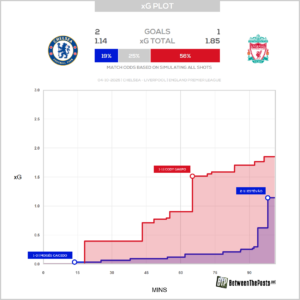
Takeaways
Maresca’s game plan worked pretty well in organized phases of the first half. Chelsea’s man-oriented defensive scheme stunted Liverpool’s buildup, and they had a clear plan on exploiting Liverpool’s right side. In the second half, they lost some control and got into a game of transitions, which benefited Liverpool. They rallied well at the end though, gaining a valuable win.
From looking at the expected goals figures for this game, one might assume that Liverpool were better for most of the game, and maybe even deserved to win. The underlying numbers reflect Liverpool still being a transition threat and Chelsea being inefficient in the final third, but don’t quite tell the story of Liverpool’s qualitative tactical deficiencies on both sides of the ball. Their pressing was exploitable due to the liberties afforded to Salah, and they were lacking ideas in buildup against Chelsea’s man-marking system in organized possession phases. Slot continues to search for the best way to integrate Liverpool’s considerable attacking talent.
Use the arrows to scroll through all available match plots. Click to enlarge.
Check the match plots page for plots of other matches.
